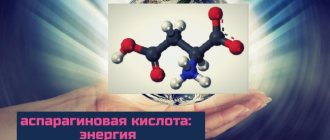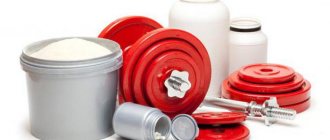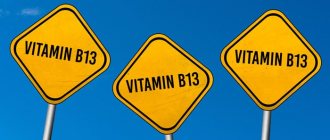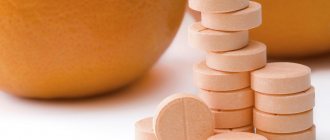Today we will talk about a drug that can be found in almost every home medicine cabinet. People resort to it at the slightest ailment without any consultation with a doctor - it has a reputation as an almost harmless medicine. In addition to its well-known formula, widely advertised in domestic and foreign media, it is also found in so-called fat burners (where it is represented by extract from white willow bark - White Willow). So what is aspirin? How and for what indications should it be used?
Aspirin or acetylsalicylic acid was invented in 1869. It is a derivative of salicylic acid (see formulas), which has been used as an antipyretic and anti-inflammatory agent. Its sodium salt, called “salicylic soda,” remained in the arsenal of doctors for a long time and is still used in some cases. However, pure salicylic acid is an extremely caustic substance and has a harmful effect on the mucous membranes of the gastrointestinal tract. Acetylsalicylic acid is less caustic mainly due to the “closed” phenolic hydroxy group.
Application in medicine
Aspirin is one of the most popular non-steroidal anti-inflammatory drugs. This is due to the breadth of its therapeutic action, and therefore its suitability for pain of almost any origin. As an anti-inflammatory, it is used for diseases and disorders accompanied by severe inflammation (in particular, dental diseases); as an antipyretic - for colds; as an analgesic - for headaches, muscle pain, joint pain.
Since salicylic acid derivatives prevent platelet aggregation (the colloquial expression: “thin the blood” is not entirely correct, since blood viscosity hardly decreases), they have found use in the treatment of a number of diseases of the cardiovascular system. For example, they are used to prevent blood clots after myocardial infarction, with increased blood clotting.
Other derivatives of salicylic acid are also used in medicine - salicylamide (anti-inflammatory and analgesic), methyl salicylate (also anti-inflammatory, but only for external use).
Possible combinations and compatibility with other medications
A huge number of drugs are produced containing aspirin, both separately and in certain combinations (for the list, see Appendices 1 and 2).
In drugs that are predominantly analgesic (such as Citramon and Askofen), aspirin is combined with other drugs of similar action. In this case, the dose of aspirin is reduced to 50-100 mg per dose. Very often, caffeine is added to the finished forms, which helps relieve spasms of cerebral vessels and thus increases the effectiveness against migraines.
Mixtures of aspirin with large doses of vitamin C (for example, Aspirin UPSA) have found quite widespread use. This combination provides a milder effect on hematopoiesis and relieves some of the side effects.
In addition, soluble forms - effervescent tablets - are absorbed faster and have a gentler effect on the mucous membranes. Alas, the final solution contains little ascorbic acid, and it has to be taken additionally.
Enteric-soluble forms (for example, Thrombo ACC) do not cause damage to the gastric wall, and can be used in the presence of ulcers or gastritis.
It should be borne in mind that aspirin enhances the effect of other anticoagulants and somewhat weakens the effect of diuretics. Taking it together with most medications requires prior consultation with your doctor.
Symptoms of high blood pressure
The more muscle we have, the more blood our body begins to produce. In addition, regular, systematic performance of anaerobic and aerobic exercises of medium and high intensity necessarily causes an enlargement of the left ventricle of the heart. The term *athletic heart* means exactly that. It is interesting that after an abrupt cessation of sports, this same heart with a hypertrophied ventricle VERY often begins to malfunction. This was proven by personal example by the great and terrible Nikolai Yasinovsky. So, if you have already spent several years on serious training with iron, then it is better to continue to do so always. Otherwise, a heart attack may occur.
So, an enlarged heart and an increased blood volume inevitably lead to the fact that an athlete’s blood pressure differs significantly from the medical norm. In general, a figure of 140/90 can be considered the norm for most pitching/strength athletes. But anything higher is extremely bad. Accordingly, if you, whether on or off a doping course, regularly experience any of these symptoms, then you need to take immediate action. The actual symptoms that indicate the presence of hypertension:
- Aching pain in the back of the head
- Increased heart rate at rest
- "Floaters" and multi-colored circles before the eyes
- Tinnitus
- Nausea
- Dyspnea
Please note that at a young age (under 30 years of age), hypertension may occur without symptoms. Therefore, make it a rule to measure your blood pressure WEEKLY. Regardless of whether you use doping or not. And one more piece of advice. Excessive protein intake, especially with reduced carbohydrate intake, makes our blood VERY thick. And the thicker the blood, the higher the pressure. The heart has to work in increased activity mode. And drink plenty of water.
Aspirin in sports
Since all elite sports are in one way or another associated with inevitable microtraumas and pain, aspirin is mainly taken by athletes as an analgesic. However, the dosages in this case are several times higher than those recommended by doctors. Aspirin is most often taken in the presence of joint damage due to its antirheumatic properties.
Where there is a high risk of thrombosis due to dehydration (prolonged competition at elevated temperatures), aspirin can also be used as a means of preventing the formation of blood clots. In this case, soluble forms enriched with vitamin C are preferred.
The combination of aspirin + a large (several grams) dose of vitamin C is very effective as an anti-flu drug; it works well even in cases where the athlete’s immune system is “damaged” by long-term training. However, in this case, additional insurance with B vitamins should be provided.
Quite curious was the property of acetylsalicylic acid to extend and possibly enhance the effect of thermogenic drugs. This is especially true for the very common “package” ephedrine - caffeine. Unfortunately, there is one peculiarity here. Although the required doses in this case do not exceed pharmaceutical ones - 1 tablet weighing 350-500 mg per 20 mg of ephedrine and 200 mg of caffeine - with the recommended three times daily dose you already receive 1050-1500 mg of aspirin, which, of course, is too much. In our opinion, the effect is not worth the risk.
Dosage of the drug
Depending on the goals pursued by the athlete, the dosage of Aspirin in sports will be different..
For the prevention of microtraumas in muscles and joints
As a prophylactic before training, bodybuilding athletes are recommended to take the drug in an amount of 500 mg once a day in crushed form. The daily dose is taken immediately and is not divided into several doses. The drug is non-toxic, but can be addictive if taken for a long time. To exclude this phenomenon, taking Aspirin should be alternated with breaks in its use.
To prevent blood clots
In this case, a daily dose of 250 mg is taken once in a course for two weeks, followed by a break of 12 to 15 days.
For the prevention of infectious diseases
Weakening of the body's immunity due to intense training by an athlete can cause the development of acute respiratory diseases or other viral infections. For the purpose of prevention, athletes are advised to take Aspirin with vitamin C, as, for example, in the drug UPSA. One effervescent tablet contains 500 mg of Aspirin. Dissolves in half a glass of water. The product is taken once a day.
Dosages and methods of administration
In medicine, doses of 0.25 to 1 g per day are used, usually in 3-4 doses. When taken independently, it is recommended to use no more than 1 tablet per day (the weight of the tablet in our country is 250-500 mg and for children it is 100 mg, in the USA it is 350 mg). It is best to take the drug after meals in crushed form.
As an analgesic and antirheumatic drug, aspirin is taken in relatively small dosages, since at doses of more than 1 g per day the antithrombotic effect is much stronger. The duration of the course is no more than a week!
How should you take acetylsalicylic acid?
It is worth noting that due to its actual safety, aspirin can be taken in sufficient quantities, but it is worth remembering. It is also not recommended to abuse these remedies. This is due to the fact that such use can lead to a decrease in effectiveness, which is associated with the development of habits in human bodies. Many professionals believe that acetylsalicylic acid should be consumed only at the correct dosage and in crushed forms. It is worth noting that dosage plays a huge role in the life of every athlete. Also, do not forget that you only need to take the drug with ordinary liquid, for example, use water or milk.
For many, aspirin in bodybuilding is a quick initial phase of action that is free of various toxins. But do not forget that any medications have a number of side effects that must be carefully studied and taken into account when taking the drug. If the drug is taken incorrectly, various ulcers, various allergic reactions, and anemia may occur. A whole range of side effects can occur only in cases of drug abuse or unique intolerance.
Side effects
The irritating effect of aspirin on the mucous membranes of the stomach has already been mentioned above. Since hydrolysis to salicylic acid is necessary for the effect to occur, such exposure may lead to ulcers with long-term use. There have even been cases of death after taking large doses: perforation of the gastric wall occurred.
In addition, long-term use of salicylates is fraught with anemia due to inhibition of hematopoiesis. In case of low blood clotting (hemophilia), the drug is generally contraindicated. It has been shown that if you are prone to asthma, even a single dose of aspirin can trigger an asthmatic attack.
All these side effects lead to the fact that they try to replace aspirin with more harmless analgesics, and components that provoke the development of disorders are removed from ready-made forms. For example, instead of the old Citramon, Citramon-P is now used, in which phenacetin is replaced by paracetamol. For pain of non-inflammatory origin (headaches), paracetamol is more acceptable, but it is ineffective for inflammation and should be replaced with ibuprofen or indomethacin.
Side effects
Side effects from the drug occur due to overdose or prolonged use by athletes. Since Aspirin is an acid, its effect on the gastric mucosa will be irritating.
The negative effect of the drug can manifest itself in the form of the following pathological conditions:
- gastritis with subsequent development of gastric ulcer;
- tinnitus and hearing loss due to the toxic effect of Aspirin on the auditory nerve;
- allergic reaction due to individual intolerance to Aspirin;
- anemia;
- increased sweating.
Side effects among bodybuilding athletes are rare, since Aspirin and drugs containing it are prescribed by a sports medicine doctor. Monitoring the concentration of the drug in the blood of athletes is carried out using laboratory methods.
CONCLUSIONS
Despite its more than 100-year history, aspirin is a highly effective analgesic and anti-inflammatory agent. That is why it has not yet been excluded from the range of medicines. However, it should be used with caution, keeping in mind the large number of side effects. In some cases, aspirin should be replaced with drugs such as paracetamol, indomethacin, butadione, and in case of acute pain - with stronger analgesics (Tramal).
Anopyrin, Apo-Asa, aspivatrin, aspilite, acylpirin, bufferin, Jasprin, Colfarit, laspal, Mikristin, Novandol, Novooan, Plidol, Ronal, Salorin, Thrombo ACC, Elkapin, Acesal, Acetylin, Aspisol, Astrin, Ataspin, Bebaspin, Bispirine , Caprin, Cetasal, Clariprin, Darosal, Durasal, Endosalil, Eutosal, Helicon, Isopirin, Monasalyl, Novandol, Panspiril, Polopyrina, Prodol, Rodopyrin, Ronal, Ruspirin, Salacetin, Saletin, Temperal, Vicapirine, Zorprin
How to take Aspirin to lose weight
People, having chosen this drug as a means of fighting excess weight, begin to ask the question: “How to take Aspirin for weight loss?”
You should know that if you limit yourself to taking Aspirin alone, you will not be able to lose excess weight. It should be taken in combination with drugs such as: Caffeine and Ephedrine.
The complex of these drugs has the following effects on the body:
- Promotes a surge of strength and enhances the effect of training;
- Speeds up metabolism;
- Promotes weight loss;
- Reduces hunger;
- Has a weak diuretic effect.
Pharmacies even sell special nutritional supplements that include a complex of these 3 substances. They are otherwise called ECA (Ephedrine, Caffeine, Aspirin).
If such a supplement is not available, then you can take Ephedrine, Caffeine and Aspirin for weight loss separately. Ephedrine cannot be bought in its pure form, because it is available by prescription, so it is replaced with Broncholitin.
This complex must be taken in accordance with the daily norm:
- Bronholitin -50 ml;
- Caffeine-250 mg;
- Aspirin-250 mg.
It is permissible to exceed a single dose by 3 times, so you can take this combination 3 times a day, for no more than 14 days in a row. Then you need to take a break for 2 weeks.











